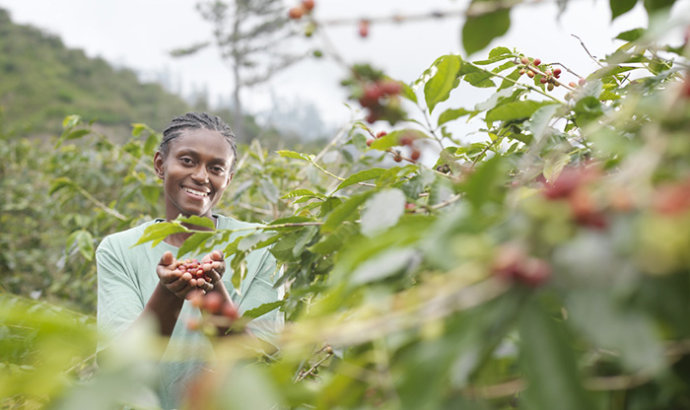The abnormal prosperity of Brazil's "coffee kingdom"

From the early 16th century to the 1820s, Portugal colonized Brazil for more than 300 years. Portugal colonial rule had a profound impact on Brazil's economy, politics, society and culture. Single product system and large estate system became fetters restricting the development of modern Brazil's economy. Due to the incomplete nature of the independence movement, Brazil continued to develop a single commodity economy based on exports of primary products along the path of colonial times during the 100 years after independence, which contributed to the abnormal prosperity of the coffee economy in the 19th century. Brazil enjoys the fruits of its coffee boom, but suffers from its ills.
The colonists pursued a single product system
In the 15th century, in order to break the Italian commercial monopoly and establish direct trade with the legendary East by water, the Portugal began to explore new sea routes and then colonial expansion. In April 1500, Pedro Álvarez Cabral's Portugal fleet unexpectedly arrived at the port of Seguro on the Bahia coast of northeastern Brazil and declared it Portugal. From then on, Portugal began to colonize Brazil.
During the conquest of America, mercantilist economic theory prevailed in Europe. According to the needs of the suzerain and the international market, the western colonists carried out a single product system in the colonies, specialized in producing one or several primary products, implemented trade protection and monopoly policies of reward and restriction, and turned the colonies into raw material producing areas and product sales markets of the suzerain. Portugal extended the single product system to Brazil, which experienced three economic cycles of rosewood, sugar and mining according to the prosperity order of export products.
The redwood economy began in the early 16th century. As an important raw material for making red dye at that time, rosewood (brasil) was very rare and valuable, known as "green gold", from which Brazil's name originated. Stimulated by the European textile industry, Portugal colonists began to harvest mahogany crazily and monopolize the mahogany trade. By the end of the 16th century, about 100 ships loaded with rosewood each year were sailing from Brazil to Portugal. Over two centuries, Portugal colonists felled some 50 million mahogany trees, and overexploitation nearly depleted the Brazilian mahogany stock. By the 18th century, the redwood economy was in decline.
Sucrose economic cycle roughly from the mid-16th century to the early 18th century. In 1502, the first sugarcane buds were introduced into Brazil from the Portuguese Madeira Islands, and large-scale cultivation began in Pernambuco and Bahia in the mid-16th century. Large-scale land ownership and slavery made it possible for sugarcane to be grown on a large scale. King João III of Portugal divided Portuguese America into 15 viceroyals, which were distributed among 12 grantees. The donated large estate mainly cultivates cash crops and operates an export economy serving the international market. Because white immigration was extremely limited and labor was scarce, Portugal colonists looted and trafficked blacks from Africa to meet the labor needs of Brazil's sugar industry. Conservative estimates suggest that between the 16th and 18th centuries, some 2 million slaves were trafficked to Brazil. Sugar cane is also known as a slave crop. From the mid-16th century to the mid-17th century, almost all European sugar was produced in Brazil. In pursuit of high profits, the Netherlands, France and Britain followed Portugal in establishing sugar cane plantations on Caribbean islands, which had a great impact on Brazil's sugar economy. In the early 18th century, Brazil's sugar crop revenues plummeted by two-thirds, and the sugar economy went into depression.
Subsequently, Portugal colonists discovered gold and diamonds in Minas Gerais, and the Brazilian economy entered a mining cycle that lasted nearly a century. In the 18th century, Brazil mined about 2 million pounds of gold, accounting for 80% of the global gold market, and produced more than 3 million carats of diamonds. On the face of it, the mining boom seems to have saved Brazil's economy and made Portugal richer. In fact, Portugal colonists, while squandering Brazilian wealth, missed out on the Industrial Revolution, became increasingly dependent on British manufactured goods, and the wealth plundered from the colonies went to other countries. Thus, gold and diamonds did not enrich Portugal and its colonies in the long run; on the contrary, they exacerbated their poverty and backwardness. The three economic cycles of redwood, sugar cane and mining brought Brazil only a misshapen and false prosperity.
Under more than 300 years of Portugal colonial rule, Brazil's economy never diversified and from the beginning was export-oriented and mono-product. External market demand determines the export situation of products, and then affects and restricts the development of colonies. Single product system, large estate system and slavery system became the main characteristics of Brazil's social and economic life in colonial period, which together constituted the abnormal economic development mode and became the shackles restricting Brazil's future economic development.
During its colonial rule, Portugal not only enslaved Indians, Blacks and mestizo, but also adopted many discriminatory policies against indigenous white Brazilians. Politically, the native-born whites could not hold high office in government, even as heirs to large landowners; economically, the colonists monopolized Brazil's import and export economy and did not allow native-born whites to interfere; moreover, the colonists imposed heavy taxes on native-born whites under various names. The political and economic rights of native-born whites were constantly squeezed. The elites among them, nourished by the European Enlightenment and inspired by the French Revolution and the American Revolution, began to work to cut off political ties with the Portugal royal family and try to break the economic monopoly of the sovereign state and conduct trade directly with other countries.

After independence, coffee economy outshines others
In 1820, revolution broke out in Portugal, and the contradiction between Brazil and the suzerain intensified day by day. On September 7, 1822, Pedro, Prince of Portugal and Regent of Brazil, declared Brazil independent. With the support of the constitutional monarchy, he was crowned emperor on December 1 as Pedro I (Portugal formally recognized Brazilian independence in 1825). Although Brazil was politically separated from the direct rule of the Portugal royal family after independence, the system of large estates, single products and slavery were preserved intact. In this sense, Brazil's independence is more like a separation movement, a "political revolution without social revolution", only the native white people replaced the rule of the "peninsula people", and did not fundamentally touch the social and economic structure of the colonial period. This "path dependence" led to the abnormal prosperity of the coffee economy since then.
In the 1830s coffee accounted for 43.8% of Brazil's total exports. Coffee cultivation peaked in the mid-19th century in the Rio de Janeiro region centered on the Paraíba Valley. 1851-1860 In 2010, Brazil produced 2.6 million bags of coffee a year. Brazil has become the world's largest coffee producer. At the height of the Paraíba Valley boom, Rio controlled 88% of Brazil's coffee exports. Coffee growers use the ancient and crude slash-and-burn method of predatory land clearing, cutting down forests to expand coffee plantations, and once a piece of land shows signs of fatigue, growers abandon it and raze new rainforests for coffee cultivation. By the 1870s, there was little new land to reclaim in the Rio region. Subsequently, the coffee economy spread west and north, and Sao Paulo became another coffee-growing center. After 1880, Brazil produced more than 5 million bags of coffee a year, and the state of São Paulo produced more coffee than Rio de Janeiro. In 1906, Brazilian coffee production jumped to 22 million bags a year. In 1908, coffee accounted for 53 percent of Brazil's total exports, monopolizing half of the export economy. So why does brazil's coffee economy stand out?
First, Brazil has the widest tropical range in the world in terms of natural conditions. Temperature, rainfall and light conditions are suitable for the growth of coffee trees, a tropical cash crop.
Second, international demand for coffee has spurred the development of Brazil's coffee industry. In the 18th century, coffee became a necessity for European and American social life. 1730-1735 World coffee consumption tripled in 2000. The huge market demand attracted coffee growers and trading companies, prompting them to scale up production.
Third, the rise and fall of the mahogany, sugar cane, and mining economic cycles created both opportunities for the rise of the coffee economy and the raw accumulation it needed for development. Since the 16th century, Rio de Janeiro has experienced two stages of development: redwood logging and sugar cane cultivation, while its neighboring state of Minas Gerais is known for mining minerals. The huge foreign exchange brought by the export of these products has provided strong funds for the coffee economy.
Fourth, immigrants provide sufficient labor for the labor-intensive economy of coffee. The first coffee plantations to emerge in northern Brazil used labor primarily from slaves left over from the sugar and mining cycles of the 16th-18th centuries. After Brazil's Congress banned the slave trade in 1850, European and Asian immigrants became a major source of labor. 1887-1897 About 1.3 million immigrants arrived in Brazil in 2010, most of them engaged in coffee cultivation and related industries.
Fifth, modern transportation such as railways and ocean-going ships greatly facilitated the export trade of Brazilian coffee. In 1874, the total length of Brazilian railways was about 1200 kilometers, increasing to about 9600 kilometers in 1889. Railroads run directly from coffee growing areas to Rio de Janeiro and Santos Port, dedicated to coffee transport, while ships facilitate coffee trade between Brazil and foreign countries. 1821-1844 Per capita consumption of Brazilian coffee in the United States jumped from 28.35 grams to 2270 grams in 2008.

The coffee industry is both a driving force and a shackle.
The coffee industry played a pivotal role in Brazil's modern economic structure, providing the driving force for urbanization, industrialization and modernization.
First, the large amount of export foreign exchange generated by the post-independence coffee economy provided the necessary financial security for Brazil's early industrialization. 1889-1919 In 2006, Brazil's industrial enterprises increased from 626 to 13566. Brazilian industrial output doubled during World War I and tripled in 1923. In addition, Brazil's industrial sector has broken through the scope of light industry, with metallurgical, chemical and pharmaceutical industries accounting for a certain proportion. This state of industrial development provided the basis for Brazil's subsequent industrialization.
Second, the infrastructure created by the coffee economy provided essential conditions for Brazil's early industrialization. In 1852, the Brazilian government enacted a law encouraging railway construction. Subsequently, Brazil set off an upsurge in railway construction, forming a railway network centered on Sao Paulo City, connecting important ports and coffee-producing areas such as Rio de Janeiro City, Santos Port and Campinas. In 1920, Brazil's railway mileage reached 27,000 kilometers. By 1915, 104 power stations had been built. Transportation and electricity played a leading role in the industrialization process.
Third, the development of the coffee industry attracted a large number of immigrants, not only achieving the prosperity of export economies such as coffee, but also promoting Brazil's urbanization process. A number of cities have emerged near the coffee industry belt and have gradually become important industrial bases in Brazil, with a rapid increase in urban population. Especially in Sao Paulo state, from 1.38 million in 1890 to 4.59 million in 1920, the capital city of Sao Paulo became the financial center, management center and distribution center of imported industrial products in southeastern Brazil.
At the same time, we should also see that the overheated coffee industry has brought many disadvantages to Brazil's economic and political life.
First of all, although coffee farming has led to the development of many industries in the surrounding areas, the impact is more vertical than horizontal. All the urban infrastructure, transportation and export processing industries related to coffee export economy have been rapidly developed, and vice versa has not changed significantly.
Second, Brazil's industrial layout is deeply influenced by the coffee industry, and the former coffee growing center is still Brazil's industrial heartland. In 1907, the coffee-rich state of São Paulo and the Federal District accounted for 49% of Brazil's industrial output, rising to 52% in 1920. This highly concentrated industrial distribution is irrational and creates an imbalance in the development of Brazil's regions.
Third, the coffee economy has led to the formation of a "coffee oligarchy" in Brazil. Coffee plantation owners with huge wealth controlled the political, economic and diplomatic power of the country by manipulating elections and forming political alliances. Between 1894 and 1930, for example, Brazil's presidents came from the "coffee triangle" of Sao Paulo, Rio de Janeiro and Minas Gerais.
Finally, excessive reliance on coffee for export as a mono-product has led to severe structural dislocations in the economy, deepening the dependency and vulnerability of the Brazilian economy. In the 1930s, the great economic crisis in western countries hit Brazil's coffee economy hard, which led to a domestic movement against "coffee oligarchy" politics. After Vargas came to power through a coup in 1930, he implemented a nationalist economic policy and started the process of import-substitution industrialization. In the mid-1950s, Brazil's industrial output exceeded agricultural output for the first time, and the industrial system began to take shape. However, due to the absence of large-scale land ownership to eradicate traditional agriculture, changes in the old political and economic structure of rural areas were very limited, and industrial development lacked internal demand and motivation.
(Author: Institute of World History, Chinese Academy of Social Sciences)
Important Notice :
前街咖啡 FrontStreet Coffee has moved to new addredd:
FrontStreet Coffee Address: 315,Donghua East Road,GuangZhou
Tel:020 38364473
- Prev

Like Swedes, sit down and enjoy coffee time
If Swedes are not crazy about religion, they should dedicate all their piety to Fika (coffee time). If Swedes are not crazy about religion, they should dedicate all their piety to Fika (coffee time). When the Swede says Lets fika to you, it means that nothing is important right now. The important thing is to drop everything and have a cup of coffee.
- Next

Coffee Culture in Portugal
Europe does not produce coffee beans, but drinks coffee into a strong cultural flavor. It is Americans who are lack of humanism, but have succeeded in exporting coffee culture to the whole world. It has even knocked on the market door of tea-drinking countries and borrowed the coffee basis of the Italians to sell popular coffee culture. It was a success. It's just that it's not really coffee that is sold. The Europeans must not be convinced. The coffee is strong.
Related
- How did the Salvadoran coffee industry develop in Central America?
- What exactly does the golden cup extraction of coffee mean?
- The Origin of Coffee flower
- [2023 Starbucks World Earth Day] there are more meaningful things besides free Starbucks coffee!
- What kind of coffee is there in Spain? 9 Flavors of Spanish Coffee
- Aromatic African coffee| Kenya's coffee culture and historical production area
- Liberica Coffee Bean knowledge: the characteristics of Liberian Coffee beans of the three original species of Coffee beans
- The origin and formula of Spanish latte introduces the taste characteristics of Bombon coffee in Valencia, Spain.
- How to adjust the solution of over-extracted coffee
- What is the tasting period of coffee beans? What is the period of coffee and beans? How should coffee wake up and raise beans?

